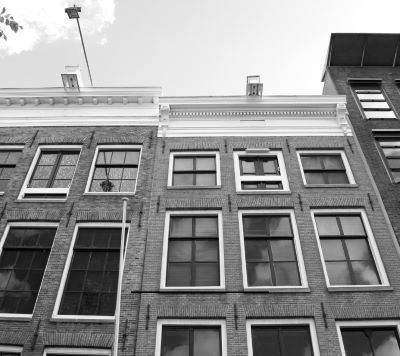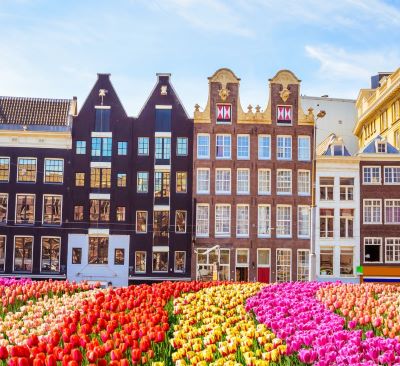Visit the Anne Frank House in Amsterdam
Explore the Anne Frank House, a significant historical site in Amsterdam where Anne Frank and her family hid during World War II. Learn about her life, writings, and the impact of the Holocaust. A must-visit museum for understanding history and discrimination.
NETHERLANDSWALKING TOUROUTDOOR ACTIVITIES
12/26/20248 min read
DISCLOSURE:
There may be affiliate links on this post. If you buy something using these links i may receive a small commission at zero cost to you.
Introduction to the Anne Frank House
The Anne Frank House, located on the Prinsengracht canal in Amsterdam, stands as a poignant reminder of the realities faced during World War II. This historical site, where Anne Frank and her family hid from the Nazis for over two years, is not just a residence but a museum dedicated to Anne's life, her writings, and the hardships endured by millions during the Holocaust. As one of the most visited museums in the Netherlands, it serves as an essential educational resource, offering visitors a profound understanding of the impact of war and discrimination.
Anne Frank, a Jewish teenager, became a symbol of the resilience of the human spirit through her now-famous diary. Her writings provide a vivid depiction of her thoughts, fears, and dreams while living in the clandestine annex. The museum aims to present not only Anne's story but also the broader narratives of persecution during this dark chapter in history. This is achieved through authentic artifacts, original documents, and carefully curated exhibits that showcase the lived experiences of those who suffered under Nazi oppression.
Visiting the Anne Frank House allows individuals to confront the brutal truths of the past, fostering a new generation of advocates for tolerance and human rights. The emotional weight of the house affects every guest, prompting reflection on the importance of remembrance and understanding. Each corner of the building tells a story filled with hope and sorrow, creating an unforgettable impact that resonates long after leaving. By preserving this crucial historical site, we not only honor the memory of Anne Frank and her family, but also reinforce the lessons learned from history to prevent repetition of such atrocities. The Anne Frank House is indeed a must-see for anyone seeking enlightenment about the trials of humanity during one of its darkest periods.
The Historical Context of Amsterdam During WWII
Amsterdam, a city renowned for its artistic heritage and picturesque canals, experienced profound changes during World War II. The German occupation of the Netherlands began in May 1940, fundamentally altering the lives of its inhabitants, particularly the Jewish community. By 1941, anti-Jewish measures escalated, restricting the rights and freedoms of Jewish residents in Amsterdam, which included mandatory identification, the exclusion from public life, and the eventual requirement to wear yellow stars. These oppressive policies marked the beginning of a dark chapter in the city’s history, culminating in the horrors of the Holocaust.
During this period, traditional neighborhoods became fraught with danger as many Jewish families were rounded up and deported to concentration camps. Amsterdam was home to approximately 80,000 Jews before the war, but only about 25,000 survived. The climate of fear and persecution forced many, including the Frank family, into hiding. The establishment of hidden places, such as the Secret Annex in the Anne Frank House, emerged as a desperate attempt to evade the pervasive violence and oppressive regime imposed by the Nazis. These concealed spaces represented a sliver of hope amidst despair, where families grappled with the uncertainties of life in hiding.
The plight of Anne Frank and her family, who spent more than two years in the Secret Annex before being discovered in August 1944, symbolized the broader tragedy experienced by Jewish families across Europe. Amsterdam's historical context during World War II provides crucial insights into the systemic dehumanization and destruction enacted on its Jewish population. Understanding this backdrop not only enhances the experience of visiting the Anne Frank House but also reinforces the moral imperative to remember and reflect upon the lessons learned from this grim period in history.
The Significance of the Anne Frank House Tour
The Anne Frank House tour offers visitors a profound and immersive experience that connects them deeply with the history of World War II and the personal narrative of Anne Frank. As attendees step into the museum, they are greeted by the haunting yet remarkable surroundings where Anne and her family sought refuge during the Nazi occupation of the Netherlands. The carefully curated exhibits illuminate not only the challenges faced by the Frank family but also the resilience of the human spirit during times of extreme adversity.
Among the key features of the tour is the Secret Annex, a hidden space where Anne, her family, and four others lived in secrecy for more than two years. Visitors are guided through the narrow staircases leading to this intimate space, fostering a palpable sense of connection to the individuals who once occupied it. The experience is accentuated by the careful preservation of the original rooms and the inclusion of multimedia presentations, which narrate the story of Anne's life, her dreams, and her aspirations. This approach humanizes history and allows guests to engage with Anne's narrative on a personal level.
The diary of Anne Frank, which serves as a crucial component of the tour, often becomes a focal point for visitors. As they read excerpts from her writings displayed throughout the museum, they gain insights into her thoughts, fears, and hopes. This spotlight on Anne's adolescence evokes empathy, inviting visitors to reflect on the very real implications of discrimination and violence. By bringing Anne Frank's story to life, the Anne Frank House tour cultivates a sense of awareness and responsibility among guests, encouraging them to engage critically with the lessons of history that remain relevant today.
Emotional Connection: The Diary of a Young Girl
The diary of Anne Frank, which she diligently maintained during her years in hiding, stands as one of the most significant literary works to emerge from the Holocaust. It provides an intimate glimpse into the life of a young girl grappling with her identity, desires, and fears amidst the backdrop of unimaginable adversity. As visitors make their way through the Anne Frank House, the profound impact of her words becomes increasingly evident, revealing how her reflections transcend time and resonate deeply with individuals across generations.
Anne's diary, originally titled "Het Achterhuis" or "The Secret Annex," captures her thoughts and experiences during the time she spent in hiding from the Nazis. Her storytelling highlights universal themes of hope and resilience, showing how she maintained her spirit despite the dire circumstances that surrounded her. Visitors who take the time to read her diary often find themselves forming a powerful emotional connection to her story, which enhances their experience within the walls of the house. This unique perspective allows visitors to understand Anne not just as a victim of her circumstances but as a young girl with dreams, aspirations, and an indomitable will to understand her place in a turbulent world.
The themes of identity and the quest for self-discovery resonate deeply through Anne's reflections. In her words, readers can identify their own struggles, fears, and hopes, creating a shared humanity that transcends the barriers of time. This emotional connection is crucial for visitors at the Anne Frank House, making it not just a historical site, but a space for personal reflection and growth. Understanding the context of her writings lends a profound depth to the visit, encouraging individuals to contemplate the lessons of history and the timeless relevance of her messages on tolerance, empathy, and the power of the human spirit.
Visitor Experience and Practical Information
Guided tours are available for those looking for a deeper understanding of the historical context of the museum. Knowledgeable guides share insights into Anne’s life, the conditions under which her family lived in hiding, and the lasting impact of her diary. Additionally, audio guides are provided in multiple languages, allowing visitors to explore at their own pace while still gaining valuable information about each exhibit.
For enhanced accessibility, Anne Frank House is equipped with features that accommodate visitors with disabilities. Ramps and lifts are available to facilitate movement within the museum, although it is advisable to confirm specific details prior to your visit. Visitor guidelines encourage a respectful atmosphere, emphasizing the importance of maintaining silence and reflection in certain areas to honor the memory of those who suffered during the Holocaust.
Timing your visit is crucial for a fulfilling experience. Early morning or late afternoon visits often result in fewer crowds, allowing ample time for contemplation. On weekends, the museum can be particularly busy, so planning during the week is advisable. Unique educational programs and exhibitions regularly complement the visit, enriching the overall experience and fostering a deeper connection with the themes of tolerance and human rights that Anne Frank’s story encapsulates. By preparing adequately, you can ensure an enlightening and impactful visit to this significant landmark in Amsterdam.
Cultural and Educational Impact
The Anne Frank House serves as a crucial center for cultural and educational initiatives, transcending its role as merely a tourist destination. This historic site is a poignant reminder of the atrocities of the Holocaust and plays a significant part in promoting tolerance, human rights, and global awareness of discrimination. The very essence of the museum lies in its commitment to educating visitors about the harsh consequences that arise when these fundamental values are ignored.
Through its various programs and initiatives, the Anne Frank House aims to instill a deep understanding of the importance of standing against injustice. The museum regularly hosts educational workshops, exhibitions, and events that engage individuals of all ages, fostering discussions about discrimination and social justice. These activities are designed not only to inform visitors about Anne Frank's life but also to inspire them to reflect on contemporary issues relating to human rights and inequality.
Moreover, the Anne Frank House collaborates with various educational organizations, schools, and community groups to expand its outreach. Special emphasis is placed on providing resources and materials that can be used in classrooms, helping to integrate the lessons of tolerance and empathy into academic curricula. This approach ultimately seeks to create a new generation of highly aware citizens who understand the importance of diversity and human rights.
In summary, the cultural and educational impact of the Anne Frank House extends far beyond its historical significance. It stands as a lasting testament to the need for vigilance against discrimination and hate, inspiring countless individuals to contribute toward a more just and equitable society. By highlighting ongoing initiatives that promote understanding and tolerance, the museum continues to fulfill its mission of ensuring that the lessons learned from the past resonate in the future.
Conclusion: A Journey Through History
The Anne Frank House stands out as an essential destination for anyone visiting Amsterdam. This iconic museum not only offers a glimpse into the life of a young girl during one of history's darkest times but also serves as a poignant reminder of the enduring human spirit and the struggle for freedom and dignity. When stepping through the door of this historic site, visitors are transported back to the 1940s, where they can experience the profound impact of Anne Frank's story and the events that transpired during World War II.
Understanding the significance of Anne Frank’s life and writings fosters deeper reflections on the importance of tolerance, acceptance, and understanding in today’s society. The museum serves as a crucial educational resource, imparting lessons that resonate across generations. It prompts visitors to reflect on the past and consider the implications it has on our present and future. In this sense, the Anne Frank House transcends the role of a mere historical site; it becomes a vessel for empathy and an advocate for human rights.
Moreover, the rich history of Amsterdam is intertwined with Anne Frank's narrative, making the house not only a site of remembrance but also a focal point for exploring the broader context of Dutch history during the war. As a visitor, engaging with this history is an opportunity to recognize the weight of the past while motivating ourselves to create a society characterized by acceptance and peace.
In conclusion, a visit to the Anne Frank House is not just about witnessing history; it’s about absorbing the life lessons that stem from it. It challenges us to remember the past, shaping our actions for a better future, and underscores the necessity of preserving stories like Anne Frank’s for years to come. A deeply moving experience awaits, making it a must-see for anyone in Amsterdam.
Alternative Anne Frank Walking Tours:










